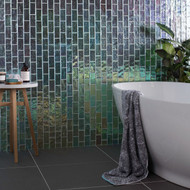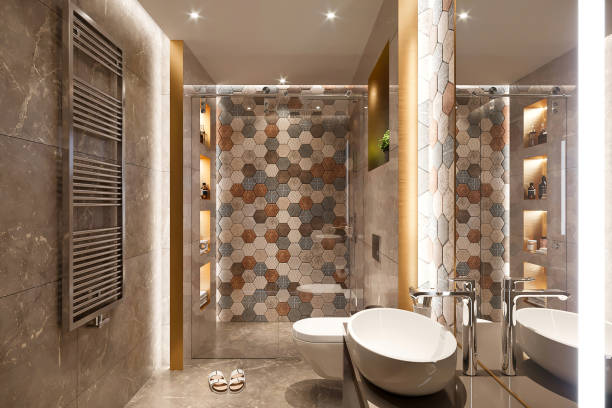A Comprehensive Guide to Choosing the Tile for Your Space
Posted by Mike Belk on Aug 25, 2023

Tile Types 101: A Comprehensive Guide to Choosing the Perfect Tile for Your Space
Welcome to Belk Tile's comprehensive guide to selecting the perfect tiles for your living spaces. As a trusted tile company, we understand the importance of choosing the right tiles to create a visually stunning and functional environment. Whether you're renovating your kitchen, upgrading your bathroom, or transforming your outdoor area, this guide will help you make informed decisions and turn your vision into reality.
Understanding Tile Types
Tiles come in various materials, each offering unique characteristics and benefits. Here's an overview of the most popular tile types:
Ceramic Tiles
Ceramic tiles are a versatile and affordable option, making them a popular choice for a wide range of applications. These tiles are made from natural clay and come in various shapes, sizes, colors, patterns, and textures. They are an excellent choice for indoor spaces with light to moderate foot traffic, such as kitchens, bathrooms, and living areas.
Advantages:
- Cost-effective compared to other tile types.
- Wide variety of designs and colors to choose from.
- Resistant to water, stains, and scratches with proper glazing.
- Easy to clean and maintain.
Disadvantages:
- Not as durable as porcelain or natural stone tiles.
- May chip or crack under heavy impact.
- Grout lines may require regular maintenance.
Porcelain Tiles
Porcelain tiles are highly durable and water-resistant, making them suitable for both indoor and outdoor spaces. They are manufactured from refined clay, making them denser and less porous than ceramic tiles. Porcelain tiles can mimic the appearance of natural stone, wood, or even fabric, providing endless design possibilities.
Advantages:
- Exceptional durability and long-lasting performance.
- Suitable for high-traffic areas, including commercial spaces.
- Resistant to moisture, stains, and fading.
- Easy to clean and maintain.
Disadvantages:
- Typically more expensive than ceramic tiles.
- Requires professional installation due to its density.
- Heavy and challenging to cut for DIY projects.
Marble Tiles
Marble tiles are synonymous with luxury and elegance. They are natural stones formed from limestone that undergoes a metamorphic process under heat and pressure. Marble tiles are available in various colors and patterns, each with its unique veining, making every piece truly one-of-a-kind.
Advantages:
- Timeless beauty and elegance.
- Unique veining patterns create a luxurious and sophisticated look.
- Suitable for low-traffic areas and decorative applications.
- Can be polished to a high shine.
Disadvantages:
- More expensive than ceramic and porcelain tiles.
- Susceptible to scratching and staining.
- Requires regular sealing to prevent damage.

Choosing Tiles for Specific Spaces
Kitchen Tiles
- Kitchen Floors: Kitchen floors endure heavy foot traffic and are exposed to spills and stains regularly. It's crucial to choose tiles that can withstand these challenges.
- Opt for porcelain tiles for durability and easy maintenance: Porcelain tiles are an excellent choice for kitchen floors as they are highly durable and resistant to stains and water. Look for tiles with a slip-resistant surface for added safety.
- Choose larger tiles to create a seamless and spacious look: Larger tiles with minimal grout lines create a sense of continuity, making your kitchen feel more expansive and open.
- Consider slip-resistant tiles for safety in high-traffic kitchens: For busy kitchens, prioritize slip-resistant tiles with a textured surface to reduce the risk of slips and falls, especially in areas prone to spills.
- Kitchen Backsplashes: The kitchen backsplash not only protects the walls from splatters but also serves as an opportunity to add a decorative element to your kitchen.
- Ceramic tiles with intricate patterns add visual interest: Ceramic tiles come in various patterns and colors, offering an opportunity to add personality and style to your kitchen.
- Glass tiles create a modern and sleek backsplash design: For a contemporary look, consider using glass tiles. They reflect light, adding brightness and depth to your kitchen.
- Use subway tiles for a classic and timeless appearance: Subway tiles are a timeless choice for backsplashes, offering a clean and versatile design that complements various kitchen styles.
- Kitchen Countertops: The kitchen countertop is a focal point of the kitchen and requires a durable and visually appealing surface.
- Porcelain tiles offer excellent heat and stain resistance: Porcelain tiles are a practical choice for kitchen countertops, as they are resistant to heat and stains.
- Granite tiles provide a natural and elegant surface: Granite tiles offer the natural beauty of stone, creating a luxurious and sophisticated kitchen.
- Consider mosaic tiles for artistic and eye-catching countertops: Mosaic tiles allow for intricate and artistic designs, making your kitchen countertops unique and captivating.
Bathroom Tiles
- Bathroom Floors: Bathroom floors must withstand moisture and daily use. It's essential to choose tiles that are water-resistant and slip-resistant.
- Porcelain tiles with textured surfaces prevent slipping: Textured porcelain tiles provide better traction, making them a safe choice for bathroom floors.
- Opt for light-colored tiles to create an airy and spacious feel: Light-colored tiles create a sense of openness, making your bathroom appear larger and brighter.
- Consider patterned tiles to add a touch of personality: Patterned tiles can add a playful or elegant touch to your bathroom, depending on your design preferences.
- Bathroom Walls: The bathroom walls are an excellent opportunity to showcase your style and create a visually appealing space.
- Ceramic tiles are a cost-effective and easy-to-clean option: Ceramic tiles are a popular choice for bathroom walls due to their affordability and low-maintenance properties.
- Marble tiles create a luxurious and sophisticated ambiance: For a spa-like experience, consider using marble tiles on your bathroom walls to create a sense of opulence.
- Use glass tiles for a modern and luminous effect: Glass tiles reflect light and add a contemporary touch to your bathroom walls.
- Shower and Bathtub Surrounds: The shower and bathtub surrounds are exposed to water and humidity, requiring tiles that can handle these conditions.
- Porcelain tiles with waterproof sealants ensure longevity: Porcelain tiles with proper sealing prevent water from seeping into the underlying structure.
- Natural stone tiles add a spa-like and relaxing atmosphere: Using natural stone tiles, such as marble or travertine, can create a serene and luxurious shower space.
- Subway tiles offer a timeless and versatile look: Subway tiles are a popular choice for shower and bathtub surrounds, offering a classic and adaptable design.
Living Areas and Bedrooms
- Living Room: The living room is a space for relaxation and entertainment, and the right tiles can enhance its ambiance.
- Opt for large-format tiles to visually expand the room: Larger tiles with fewer grout lines create an illusion of spaciousness.
- Choose wood-look tiles for a warm and inviting atmosphere: Wood-look tiles provide the beauty of hardwood flooring with added durability and easy maintenance.
- Incorporate accent tiles to add a touch of elegance: Accent tiles can be used to create visual interest and focal points in your living room.
- Bedrooms: Bedrooms should be comfortable and inviting, and the right tiles can contribute to this ambiance.
- Soft and comfortable carpet tiles create a cozy feel: Carpet tiles offer a comfortable surface underfoot, making your bedroom cozy and warm.
- Porcelain tiles with wood patterns offer a rustic charm: Wood-patterned porcelain tiles provide the natural warmth of wood flooring with added durability.
- Consider large marble tiles for a luxurious and sophisticated bedroom: Marble tiles create an elegant and luxurious ambiance, perfect for creating a sophisticated bedroom retreat.
Outdoor Spaces
- Patios and Decks: Outdoor tiles need to withstand weather conditions and heavy use.
- Porcelain tiles with slip-resistant surfaces are ideal: Outdoor tiles should have a textured surface to prevent slipping, especially in wet conditions.
- Choose earth-tone tiles for a seamless transition to nature: Earth-tone tiles blend well with the natural surroundings, creating a harmonious outdoor space.
- Use concrete tiles for a contemporary and durable outdoor space: Concrete tiles are durable and low-maintenance, making them ideal for patios and decks.
- Poolside Areas: Tiles around the pool need to be water-resistant and slip-resistant.
- Opt for textured tiles to prevent slips and falls: Textured tiles provide better traction, reducing the risk of accidents near the pool.
- Porcelain tiles withstand pool chemicals and weather conditions: Porcelain tiles are resistant to pool chemicals and weathering, making them a reliable choice for poolside areas.
- Mosaic tiles add a playful and decorative touch to pool areas: Mosaic tiles allow for artistic designs, creating a visually appealing poolside space.
Tile Sizes and Patterns
Selecting the right tile size and pattern can significantly impact the visual appeal of your spaces. Here are some considerations:
Tile Sizes
- Larger tiles create an open and spacious feel: Large-format tiles, such as 24x24 inches or larger, visually expand the room and reduce the number of grout lines, making the space look more seamless.
- Smaller tiles add intricate detailing and visual interest: Smaller tiles, such as mosaic or 6x6 inches, are perfect for adding intricate patterns or visual interest to your design.
- Combining different tile sizes adds depth and dimension: Mixing different tile sizes can create a sense of depth and dimension, adding visual intrigue to your space.
Tile Patterns
- Herringbone patterns offer a classic and elegant look: Herringbone patterns create a timeless and sophisticated design that works well in various settings.
- Basketweave patterns provide a charming and timeless appeal: Basketweave patterns add a touch of elegance and texture to your space.
- Versailles patterns bring a sophisticated and luxurious ambiance: Versailles patterns feature a mix of different-sized tiles arranged in an intricate and opulent layout.
Creative Layout Ideas
- Diagonal tile layout adds a dynamic and unique touch: Diagonal tile layouts create a sense of movement and energy, making your space stand out.
- Running bond pattern creates a modern and contemporary feel: Running bond patterns, commonly used with subway tiles, provide a clean and modern look.
- Checkerboard layout offers a playful and retro design: Checkerboard patterns are classic and versatile, lending a playful and retro vibe to your space.
Tile Colors and Finishes
Understanding Color Psychology
Color psychology plays a significant role in shaping the atmosphere of a room. Here are some considerations when choosing tile colors:
- Neutral colors promote relaxation and versatility: Neutral colors, such as beige, gray, or cream, create a calming and versatile backdrop that complements various design styles.
- Warm colors evoke coziness and comfort: Warm colors, such as shades of brown, red, and orange, create a cozy and inviting atmosphere.
- Cool colors create a calming and serene atmosphere: Cool colors, such as blue, green, and lavender, bring a sense of tranquility and relaxation to your space.
Selecting the Right Finish
Tile finishes impact both aesthetics and functionality. Here are the most common finishes and their characteristics:
- Matte finish provides a non-reflective and subtle appearance: Matte tiles have a soft and understated look, suitable for spaces that require a muted or rustic ambiance.
- Glossy finish adds a bright and reflective surface: Glossy tiles have a shiny and reflective surface that enhances the brightness of a room, creating a more open and airy feeling.
- Textured finish adds depth and grip for high-traffic areas: Textured tiles have a rough surface, providing better traction and making them ideal for high-traffic spaces and outdoor areas.
Creating a Cohesive Design Theme
To achieve a cohesive and harmonious design, consider the following tips:
- Choose complementary tile colors for a harmonious look: Select tiles that complement each other in terms of color and undertones, creating a sense of balance and unity in your design.
- Use contrasting colors to make specific areas stand out: Contrasting colors can be used strategically to highlight focal points, architectural features, or specific areas within a room.
- Incorporate accent tiles to add visual focal points: Accent tiles, such as decorative tiles or mosaics, can serve as eye-catching focal points in your design.
Grout and Sealant Considerations
Choosing the Right Grout Color
Grout color significantly impacts the overall appearance of your tiles. Consider the following factors when selecting grout color:
- Matching grout color creates a seamless and uniform appearance: Using grout that matches the color of your tiles creates a clean and cohesive look, minimizing the visual impact of grout lines.
- Contrasting grout color highlights the individual tiles: Choosing a grout color that contrasts with the tiles can create a grid-like effect, emphasizing the individual tiles and creating a unique look.
- Light-colored grout for dark tiles and vice versa to avoid staining: Light-colored grout is recommended for dark-colored tiles to prevent staining and discoloration over time.
Proper Grout Application and Maintenance
Proper grout application and maintenance are essential for the longevity and beauty of your tiled surfaces. Here are some tips:
- Ensure correct grout thickness and spacing for durability: Properly applied grout should have a consistent thickness and spacing between tiles, ensuring durability and preventing moisture infiltration.
- Regularly clean and reseal grout lines to prevent moisture damage: Regular cleaning and resealing of grout lines prevent mold, mildew, and water damage, prolonging the life of your tiled surfaces.
- Use grout with antimicrobial properties for bathroom and kitchen areas: For areas prone to moisture and bacteria growth, such as bathrooms and kitchens, consider using grout with antimicrobial properties for added protection.
Sealant Options for Tile Protection
Sealing your tiles is essential to protect them from stains, moisture, and other forms of damage. Here are some common sealant options:
- Penetrating sealers protect natural stone tiles from stains: Penetrating sealers seep into the porous surface of natural stone tiles, providing protection against stains and water damage.
- Topical sealers offer enhanced shine and protection for polished tiles: Topical sealers create a protective layer on the surface of polished tiles, enhancing their shine and durability.
- Enhancing sealers enrich the color and texture of tiles: Enhancing sealers deepen the color and texture of tiles, making them appear more vibrant and attractive.
Tile Installation and Maintenance
Hiring a Professional Installer vs. DIY
Deciding whether to hire a professional installer or embark on a DIY project depends on various factors:
- Professional installation ensures proper alignment and longevity: Professional installers have the experience and expertise to ensure precise tile alignment and a durable installation.
- DIY installation can be cost-effective for small projects with proper guidance: For small projects and simple layouts, DIY installation can be cost-effective. However, ensure you follow best practices and guidelines for successful results.
- Consider skill level and complexity of the installation before deciding: Complex tile patterns or specialty tiles may require the expertise of a professional installer to achieve the desired outcome.
Common Tile Installation Mistakes to Avoid
Tile installation requires attention to detail and careful execution. Avoid these common mistakes:
- Uneven surfaces result in lippage and potential trip hazards: Proper surface preparation is crucial to achieving a level and even tile installation.
- Inadequate waterproofing in wet areas can lead to water damage: Ensure proper waterproofing in areas like bathrooms and kitchens to prevent water seepage and potential structural damage.
- Failure to use spacers leads to uneven grout lines and an unprofessional look: Spacers ensure even grout lines and a polished finish. Be sure to use them during installation.
Tile Maintenance Tips for Long-Lasting Beauty
Proper tile maintenance is essential to preserve the beauty and longevity of your tiled surfaces. Here are some tips:
- Regularly sweep and mop to prevent dirt buildup: Regular maintenance prevents dirt and debris from accumulating and scratching the tile surface.
- Use pH-balanced cleaners to avoid damage to the tile surface: Avoid harsh chemicals that can damage the tile finish. Instead, use pH-balanced cleaners to clean your tiles effectively and safely.
- Address any chipped or cracked tiles promptly to prevent further damage: Repair or replace damaged tiles as soon as possible to prevent further issues and maintain the integrity of your tiled surfaces.
Conclusion
Choosing the right tiles for your space is a crucial decision that impacts the overall aesthetics and functionality of your home or business. With this comprehensive guide, you now have the knowledge to make informed choices. At Belk Tile, we are committed to providing the finest tile selections and exceptional customer service. Reach out to our team to explore our collections and transform your space into a work of art.



